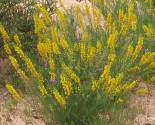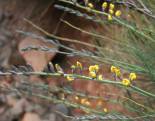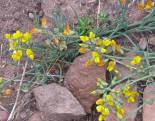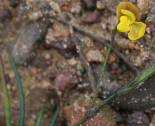Lebeckia
Lebekia Thunb.
Family: Fabaceae
Common names: ganna (Afr.)
Introduction
The genus Lebeckia is a group of 14 species that occur in the Northern, Western and Eastern Cape Provinces of South Africa. All the species have attractive yellow flowers and distinct needle-shaped leaves.

Description
Description
The species are erect to prostrate, multi-stemmed, glabrous suffrutices (subshrub) up to 1 m in height. Branches green. The leaves are simple, acicular (needle-shaped), without or rarely with stipules, spirally arranged, glabrous (without hairs) or rarely pubescent (hairy), sometimes with an articulation or indentation near the middle. Inflorescence racemose, multi-flowered; flowers bright yellow, glabrous. Calyx equally or subequally lobed; lobes deltoid or triangular. Stamens with five long and five short anthers. Pods linear or ovoid, straight or falcate (curved like a sickle), terete (round in cross section) to flat, many-seeded, bursting open in some species. Seeds reniform or kidney-shaped, variously coloured, surface rugose (roughly textured) (see Le Roux and Van Wyk 2007, 2008, 2009).
Flowering time: Mainly flowering in late winter, spring and summer (June to January).
List of species:
- L. ambigua E.Mey.
- L. brevicarpa M.M.le Roux & B.-E.van Wyk
- L. brevipes M.M.le Roux & B.-E.van Wyk
- L. contaminata (L.) Thunb.
- L. gracilis Eckl. & Zeyh.
- L. grandiflora Benth.
- L. longipes Bolus
- L. meyeriana Eckl. & Zeyh.
- L. pauciflora Eckl. & Zeyh.
- L. plukenetiana E.Mey.
- L. sepiaria (L.) Thunb.
- L. uniflora M.M.le Roux & B.-E.van Wyk
- L. wrightii (Harv.) Bolus
- L. zeyheri M.M.le Roux & B.-E.van Wyk
Conservation Status
Status
Red List assessments from Raimondo et al. (2009):
- Least Concern (LC): Lebeckia ambigua, L. brevipes, L. longipes, L. pauciflora, L. sepiaria, L. wrightii
- Critically endangered (CR): L. brevicarpa CR A2bc; C2a(i);
- D Critically endangered, possibly extinct (CR PE): L. zeyheri CR PE
- Endangered (EN): L. gracilis EN A2bc; B1ab(ii,iii,iv,v), L. meyeriana EN A2b, L. plukenetiana EN A2bc
- Rare: L. grandiflora Rare, L. uniflora
- Rare Data deficient (DD): L. contaminata DDT
Distribution and habitat
Distribution description
The species of Lebeckia occur in the Northern, Western and Eastern Cape from the Namaqualand south to the Cederberg, West Coast, Cape Peninsula and east along the coast and inland mountains as far as Port Elizabeth.
Derivation of name and historical aspects
History
The name Lebeckia commemorates H. J. Lebeck (?-1800) who was a merchant and collector in Indo-Malaya and a student of Carl Thunberg. Until recently the genus comprised some 39 species. Most of these species were moved from the genus following studies based on DNA-sequence data and morphology which revealed that the genus Lebeckia is not a natural group, i.e. polyphyletic (Boatwright et al., 2008; Boatwright et al., 2009, 2010). Nine of the species were moved into a newly described genus Wiborgiella, while for the remaining 16 species an old generic name Calobota was reinstated.
Ecology
Ecology
The species of the genus are found in a variety of habitats. They may occur in deep sand, rocky soil, moist loam, sandstone and disturbed roadsides in fynbos and renosterveld vegetation, often at high altitudes. Most of the species are usually particularly prolific after fire. Lebeckia uniflora and L. wrightii are fire weeds, i.e. annuals or short-lived perennials which grow rapidly and mature in post-fire fynbos and disappear soon thereafter. In these two species the seeds are black mottled with white (Le Roux and Van Wyk 2009). As these short-lived species occur in recently burnt vegetation, the black colour could serve to camouflage the seeds as there would be no undergrowth to cover them. These characters are also found in two Wiborgiella species, W. inflata and W. vlokii (Boatwright et al., 2010).
Uses
Use
There is no recorded ethnobotanical use for Lebeckia.
Growing Lebeckia
Grow
As Lebeckia species are not usually cultivated, details on growing them are unavailable. However, the conditions will likely be similar to those used for other fynbos legumes that are presently in cultivation, e.g. Aspalathus, Liparia and Podalyria. These are largely grown in well-drained soil and need water during winter in summer-rainfall areas. Seeds of Lebeckia can be purchased at selected seed suppliers, and germinate readily after scarification. Some species, especially L. sepiaria and L. brevicarpa, could be striking garden specimens with their many sweet-scented, yellow flowers.
Species

Lebeckia ambigua has a predominantly coastal distribution from Namaqualand south to the West Coast. It has leaves with an indentation near the middle, small flowers and linear, straight or falcate (curved like a sickle) pods that burst open to release the seeds. This species is typically found in deep sand or disturbed roadsides.

L. contaminata is a widely distributed species that occurs from Algeria to the Cape Peninsula and east to Bredasdorp. It has a decumbent or sprawling habit, leaves with an indentation near the middle and laterally compressed, stalked pods containing light pink seeds with a rough surface.

L. pauciflora is the most widely distributed of all Lebeckia species and occurs from the Kamiesberg south to Caledon and eastwards as far as Steytlerville. It has articulated (northern and southern populations) and non-articulated (eastern populations) leaves, calyx lobes that are longer than the tube, keel petals that are spirally twisted and large, flat pods.

L. plukenetiana is distributed from the Cape Peninsula to Piquetberg, Hex River and Worcester and favours mountain slopes. It has unarticulated leaves, wing petals that are longer than the keel petals and is one of only two species that have a narrowly winged upper suture of the pod (the other is L. meyeriana).

L. sepiaria is arguably the most striking and well-known of the species. It is distributed from Clanwilliam to Worcester and east to Swellendam. It has an erect habit, dense leaves, many-flowered inflorescences and pods that are round in cross-section and do not burst open to release the seeds.

L. wrightii is an annual pyrophyte or fireweed that occurs from the Cape Peninsula eastwards to Kogelberg and the Palmiet River Mountains. This species and L. uniflora are unique in the genus in that they have small, rudimentary stipules and hairs on the leaves, bracts, bracteoles and calyx. It has a spirally twisted keel (like L. pauciflora), large obovate wing petals, flat, straight pods and rugose black seeds mottled with white.
References
- Boatwright, J.S., Tilney, P.M. & Van Wyk, B.-E. 2009. The generic concept of Lebeckia (Crotalarieae, Fabaceae): Reinstatement of the genus Calobota and the new genus Wiborgiella. South African Journal of Botany 75: 546–556.
- Boatwright, J.S., Le Roux, M.M., Wink, M., Morozova, T. & Van Wyk, B.-E. 2008. Phylogenetic relationships of tribe Crotalarieae (Fabaceae) inferred from DNA sequences and morphology. Systematic Botany 33: 752-761.
- Boatwright, J.S., Tilney, P.M. & Van Wyk, B.-E. 2010. Taxonomy of Wiborgiella (Crotalarieae, Fabaceae), a genus endemic to the Greater Cape Region of South Africa. Systematic Botany 35: 325-340.
- Le Roux, M.M. & Van Wyk, B.-E. 2007. A revision of Lebeckia sect. Lebeckia : The L. sepiaria group. South African Journal of Botany 73: 118-130.
- Le Roux, M.M. & Van Wyk, B.-E. 2008. A revision of Lebeckia sect. Lebeckia : The L. plukenetiana group (Fabaceae, Crotalarieae). South African Journal of Botany 74: 660-676.
- Le Roux, M.M. & Van Wyk, B.-E. 2009. A revision of Lebeckia sect. Lebeckia : The L. pauciflora and L. wrightii groups (Fabaceae, Crotalarieae). South African Journal of Botany 75: 83-96.
- Raimondo, D., L. von Staden, W. Foden, J. E. Victor, N. A. Helme, R. C. Turner, D. A. Kamundi, and P.A. Manyama (editors). 2009. Red List of South African plants. Strelitzia 25. South African National Biodiversity Institute, Pretoria.
Credits
Stephen Boatwright
Compton Herbarium :Kirstenbosch Research Centre
February 2011
Plant Attributes:
Plant Type: Perennial, Shrub
SA Distribution:
Soil type:
Flowering season:
PH:
Flower colour:
Aspect:
Gardening skill:
Special Features:
Horticultural zones






Rate this article
Article well written and informative
Rate this plant
Is this an interesting plant?
Login to add your Comment
Back to topNot registered yet? Click here to register.